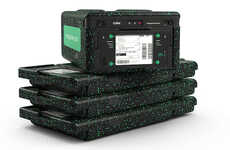
These 4D Boxes Self-Assemble Using Materials That Heat at Different Speeds
Cadhla Gray — September 28, 2015 — Unique
References: news.gatech.edu & futurity.org
Scientists from the Georgia Institute of Technology have discovered a way to design self-folding structures from materials that move or expand based on heat. Using shape-memory polynomers (SMPs), they created boxes out of different materials, layered and folded in specific ways.
When the materials heat up, they transform in different but corresponding ways so that they can fold themselves automatically. Since they heat and move at different speeds, each section of the box doesn't interfere with another.
The completed box resembles a postal box, showing its potential in the real world. These self-folding structures could be used to ship things flat that would later expand into a box or tube. While the uniform heat for this prototype came from a tank of water, the scientists hope to achieve the same technique with air heating, light or moisture.
When the materials heat up, they transform in different but corresponding ways so that they can fold themselves automatically. Since they heat and move at different speeds, each section of the box doesn't interfere with another.
The completed box resembles a postal box, showing its potential in the real world. These self-folding structures could be used to ship things flat that would later expand into a box or tube. While the uniform heat for this prototype came from a tank of water, the scientists hope to achieve the same technique with air heating, light or moisture.
Trend Themes
1. Self-folding Structures - Materials that move or expand based on heat can create self-folding structures, leading to opportunities in packaging and construction.
2. Shape-memory Polymers (smps) - SMPs can be used to create self-folding structures, leading to opportunities in material science and engineering.
3. 4D Printing - The use of materials that transform based on heat for self-folding structures reflects the growing trend of 4D printing, leading to opportunities in robotics and manufacturing.
Industry Implications
1. Packaging - Self-folding structures can revolutionize flat-packaging transportation, leading to opportunities in logistics and shipping.
2. Construction - Self-folding structures can streamline building processes, leading to opportunities in architecture and building design.
3. Material Science - The use of SMPs and self-folding structures can impact the development of new materials, leading to opportunities in material R&D and innovation.
4.9
Score
Popularity
Activity
Freshness























